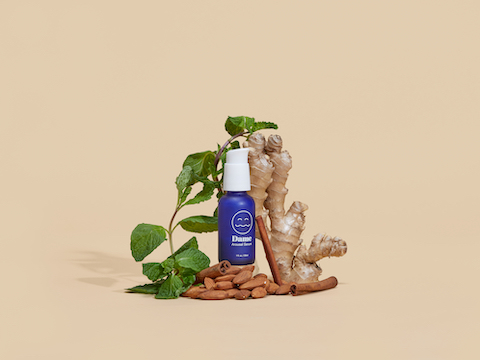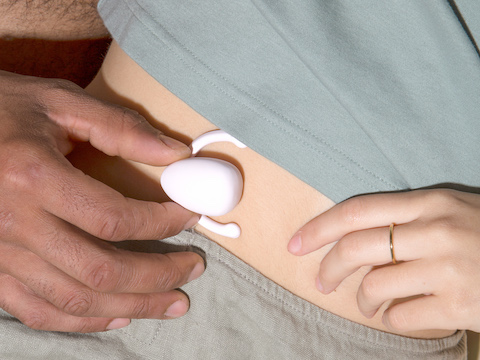This post is offered in partnership with our friends at Dame. They’re an eco, sexy, fun company dedicated to spreading sexual pleasure and education. We’re honored to work with them. ~ ed.
~
My partner calls me a 15-year-old boy trapped in a woman’s body.
I like sex, and I love to talk about it: the sex I’ve had, my fantasies, the toys that intrigue me, the props and play I’d like to experiment with, the places I’d like to get it on—you name it.
I’m the queen of “that’s what she said” jokes, and I’d like to say I’m the princess of innuendo, but truthfully, I’m too on the nose for that. So, you’d think when it comes to talking with a partner about what I want in bed, it would come naturally.
Nope. Especially if the chat involves needing something outside of my partner’s anatomy to spark the big O.
Take this quiz & find the perfect “conversation starter” >>
This past year, my long-distance lover turned into a live-in relationship. Our novel, “I’m so happy to see you” sex turned into the “where do we fit this into our daily or at least weekly or at the very, very least monthly lives” conversation.
On a surface level, I could sum up any dissatisfaction with my love life with the common phrase, “I want more sex.” My partner, on the other hand, might tell you that he wants more “intimacy.” Our mutual yearning to have our own needs met can sometimes leave us feeling as if we’re in a stand-off. (Cue the flute-like sound effect as two Spaghetti Western cowboys glare at each other from opposite ends of a deserted Main Street).
We’ve spent hours and hours thinking and talking about what we want—the sex we’re having or not having—but haven’t been getting to the core of the issue: understanding the ways that sex is important to each of us, and the meaning behind it all.
What does sex mean to you?
It’s a simple question posed by Somatic Psychotherapist, Licensed Marriage & Family Therapist (LMFT), and Certified Sex Therapist (CST) Dr. Holly Richmond on Swell, the sexual health and pleasure resource produced by Dame—a sex-forward company focused on sexual wellness by building welcoming community, designing innovative tools and toys, and bringing life-changing education to your bedroom. But that “simple” question weighed on me like a yoni egg nestled among my lady parts. Oh! Well, that’s different!
This Arousal Serum had us gently tingling and positively dripping (no, seriously!) >>
I hadn’t asked myself that question before, but it made sense that understanding the core belief systems that my partner and I hold around sex would be key to having the sex life we want.
“By exploring the meaning of sex and intimacy (rather than specific acts of them),” Richmond says, “couples have an opportunity to come into alignment and co-create an erotic space that is equally satisfying.”
That sounds freaking amazing! But how the heck do we figure that out?
These three questions are a good place to start:
1. What are your definitions of sex and intimacy?
It might seem like sex and intimacy are oppositional—particularly if we need more sex and our partner needs to feel closer to us in order to fulfill that need. But sex and intimacy are—well—intimately connected at their core. Things between the two only begin to feel divisive when our needs for physical or emotional closeness fail to be met.
“Many couples have good or even great sex when they have it; it’s trudging through emotions like sadness, anger, resentment and contempt before taking their clothes off that gets in the way. It’s often not a problem of mechanics, but rather of past, unresolved grievances” ~ Dr. Holly Richmond
So, try as we may not to, my partner and I have fallen into a rather common relationship pattern (oh thank God, we’re normal!): one or both of us tells ourselves we’re justified in not giving the other the intimacy and sexual relationship they want because we aren’t getting the intimacy and sex we want.
Here’s how it goes: my extroverted adventurer of a beau prioritizes getting his energy from exploration and socializing with our multiple friend groups over organizing the home or tackling our to-do list. I tag along, but as an introvert, I prefer the sanctuary of a clean home space and need time to myself to recharge.
What depletes me and causes me to feel distant, energizes him and creates feelings of connection: when he’s randy after a great evening that we’ve shared with friends, I can feel distant, socially overloaded, or distracted by my messy home; I can’t get in the mood.
Looking for a little hands-free partnered play? Eva stays in place with flexible wings that tuck under labia during sex >>
So we try to balance—unsuccessfully. We fall into a merry-go-round pattern of speaking different “languages.” It spins and spins, but we both want to get off (pun intended). To do that, Richmond says we need to understand each other’s definitions of “sex” and “intimacy”—and shed any contempt or resentment.
“Intimacy to one person is not intimacy to another, and the same goes for sex,” Richmond says. “Starting with the latter, it’s important for each partner to understand what’s being asked for when sex is stated as a need.”
It could mean penetration, oral, anal, or even just making out. For me, sex usually means an intent to orgasm—preferably with penetration and likely with a little added clitoral stimulation from a toy. (By the way, it’s totally normal to need a li’l extra when doin’ the somethin’ somethin’. Fewer than 50 percent (1) of women experience orgasm with vaginal intercourse alone.
Once we understand our definition of sex—whatever that might be—we can start to share those previously unexpressed expectations that have gotten in the way of our pleasure.
The trick is to have fun learning how you define and experience sex, intimacy, and pleasure. It’s important to bring an attitude of play and curiosity into the conversation as you find your vibe (that’s your cue to take the quiz!) and that’s what Dame is all about—designing a plan for pleasure that works for the both of you.
Lucky for me, I had an excuse to bring the topic up as a work project. Oh, look, it’s a package from work! Let me read you this article I’m writing. Let’s answer these questions together. And so, as Richmond encouraged, we made sure to treat ourselves to some “research time” together. Lots and lots of “research time.”
I let him feel the silky silicone skin of Dame’s G-spot targeted Arc, detailed the tingly—and, um, juicy? Yeah, we’ll say juicy—effects of their Arousal Serum, and I placed the mouth of their Aer vibrator onto his fingertip to let him feel the suction patterns that mimic the flick and suck of mouth and tongue.
Is oral your desire? Aer creates thrilling pulses of air and a soft seal around your rosebud. >>

But we’re not talkin’ sexual research alone, here; we’re talking about a deep dive into intimacy as well.
When we crave intimacy, Richmond notes that the root desire is to be truly seen and understood. This is where releasing resentment through a give-and-take balancing act of tending to each other’s needs is important. That might mean participating in tidying the home together, or spending time with our partner around their friends to make room for seeing and loving the person in their element, sure. But when speaking about sexual intimacy specifically, it’s important to explore what that means to each person.
For me, sexual intimacy means any sort of sexual pleasure. Intimacy is tender and when we’re interested in connection over primal pleasure, while still stimulating arousal to a certain degree. It can (but doesn’t necessarily) include my definition of sex.
That’s a big discernment that I didn’t have the language for. And when we are armed with the words to express what we’re looking for in a sexual experience, we’re more likely to find ways to help ourselves and our partners feel fulfilled.
2. What are sex and intimacy about?
Try this phrase on: “If our sex life were perfect, I would _____and then you would feel more ________.”
This is one of Richmond’s favorite exercises to walk clients through when helping them to fine-tune their definition of intimacy and sex. The first blank, she says, pertains to sex; the second to intimacy. Both, in the end, often depict a desired connection requested in slightly different ways.
As I filled in those blanks many times over, I discovered a clear delineation between the connection I’m looking for when I want sex versus when I desire intimacy with my partner. I was struck by the positive impact of this exercise.
As Richmond says, “with a continual practice in curiosity, which includes radical inquiry of ourselves and our partners, couples create a unique opportunity to find common erotic ground.”
It got my brain buzzing: what better way to express curiosity than perhaps bringing a toy in to serve as that conversation starter—and in a fun, light-hearted way.
3. What are the specifics behind your needs?
No matter how long you’ve been together and no matter how well you’ve talked through these questions with your partner, there’s one thing that holds true: your partner isn’t a mind reader.
We all need to be specific about two things each and every time we are asking for sex or intimacy:
>> What do I need to feel?
>> How do I want my partner to feel?
When stressed, maybe you need a physical release and want your partner to enjoy the pent-up passion of it all. Maybe you need to feel little-spooned into intimacy and want your partner to feel like the strong support pillar you think they are. Maybe you’re flat-out frisky, need to be devoured, and want your partner to feel empowered to play and experiment with your body using all the toys in your box (pun intended).
The combinations are endless.
~
When we are aware of exactly what we desire from a sexual experience on any given day, so might be our ability to experience the highest possible sexual pleasure.
If you’re ready to get experimental and tell your partner exactly what you want, Dame’s got a couple little trinkets that can help you make the exploration “O” so sweet.
~
References:
(1) https://www.psychologytoday.com/us/blog/all-about-sex/200903/the-most-important-sexual-statistic





Read 10 comments and reply